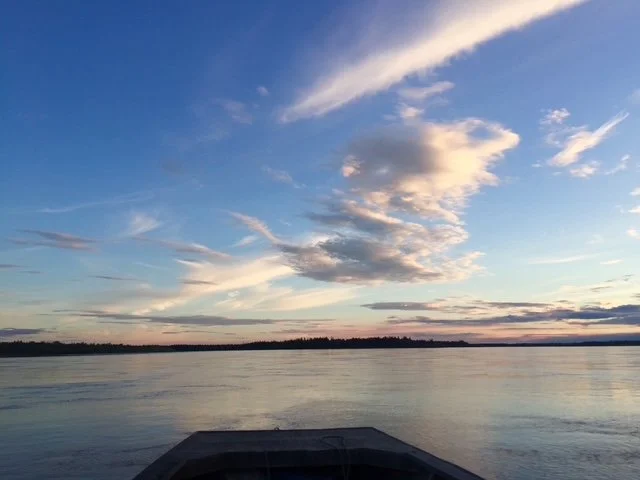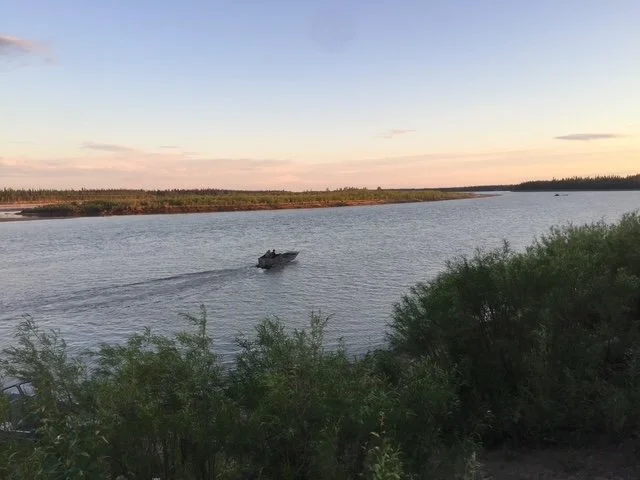
Yukonjik K’aahtii Naįį
Yukonjik K’aahtii Naįį, or the Yukon River Protectors, work to educate and uplift the people of the Yukon Flats and the Interior, with a deep connection to our traditions, ways of life, and fisheries. Rooted in the wisdom passed down through generations, we are committed to protecting the Yukon River from the harmful impacts of oil and gas development, particularly from Doyon and Hilcorp.
We stand for salmon, advocating for subsistence users, and reclaiming our role as stewards of the land.
Contact: Rochelle Adams, Director, radams@beavercouncil.org
Our Story
The Yukon River Protectors were born out of a deep-rooted concern for the health of the Yukon River and its salmon, as well as a broader need to address the inequities in resource management and protect the land from external threats. The group emerged during the Yukon River salmon crisis, when declining salmon populations highlighted the unsustainable management practices that have long been a problem for Indigenous communities along the river. As our communities faced growing challenges, we realized that our voices were not being heard in decision-making processes that directly impacted our way of life. Adding to the urgency was the looming threat of oil and gas development being pursued by our own Native corporation, which could jeopardize the health of the land, air and water and all that live here.
Our mission is to protect the sacred lands and waters that sustain our people, culture, and future generations. As Indigenous Tribal peoples, we honor our deep connection to all relatives and our home. We commit to safeguarding these natural resources through traditional knowledge, sustainable practices, and respectful stewardship. We stand united in defending our ancestral territories from harm, ensuring that our lands and waters remain healthy and abundant for the generations to come.
The Yukon Flats is home to the Gwich’in people who have lived on these lands and waters since time immemorial. They live in ten Tribal communities: Arctic Village, Venetie, Circle, Fort Yukon, Beaver, Stevens Village, Rampart, Canyon Village, Chalkyitsik, and Birch Creek.
The Gwich’in Nation stretches farther, into the Northwest and Yukon Territories First Nations of Canada.
The Yukon Flats National Wildlife Refuge is also the 3rd largest Wildlife Refuge in the Nation and the largest waterfowl breeding ground in North America.
It is a major river basin with tens of thousands of lakes, ponds, and streams acting as a unique refuge for over 160 species of birds, 18 species of fish, and 39 mammal species. Importantly, the Yukon River is the water source for people living along its banks.
The Yukon Flats
The Doyon-Hilcorp Deal
Our regional Native corporation, Doyon Limited, LLC, went into a deal with Hilcorp for Oil and Gas exploration with the Birch Creek Native Corporation without any knowledge or consent of any shareholders of the area. The local Tribes became aware of the deal from the public news in December 2019. This devastating news created a crisis across the River as Doyon went into this deal with Hilcorp and Birch Creek without the knowledge and consent of the Tribes, land owners, and their own Doyon shareholders.
Who is Hilcorp?
A private company based out of Texas, Hilcorp carries a heavy list of infractions, non-compliance, and even workers' deaths. This list is not exhaustive and has not been updated for 2025.
From 2000-2024, Hilcorp has accrued 66 environmental violations and 3 major workplace safety violations.
Hilcorp started operating in Alaska’s Cook Inlet region in 2012. Within 3 years, the Company received 25 violations from regulators. The Alaska Oil and Gas Conservation Commission (AOGCC) stated, “The disregard for regulatory compliance is endemic to Hilcorp's approach to its Alaska operations and virtually assured the occurrence of this violation...Hilcorp's conduct is inexcusable."
In 2015, three North Slope workers were nearly killed when they were overcome by nitrogen that leaked during a well clean-out process. More recently, a methane leak from an aging pipeline on the seafloor of Cook Inlet was not stopped for months. The Company said it was unable to fix the leak as long as winter ice was on the water, but some allege Hilcorp was unwilling to shut the pipeline because it would also curtail some oil production.
On Feb. 28, 2015, a pipeline at Milne Point, a North Slope facility that Hilcorp took over from BP, spilled nearly 10,000 gallons of crude oil and contaminated water onto the tundra.


